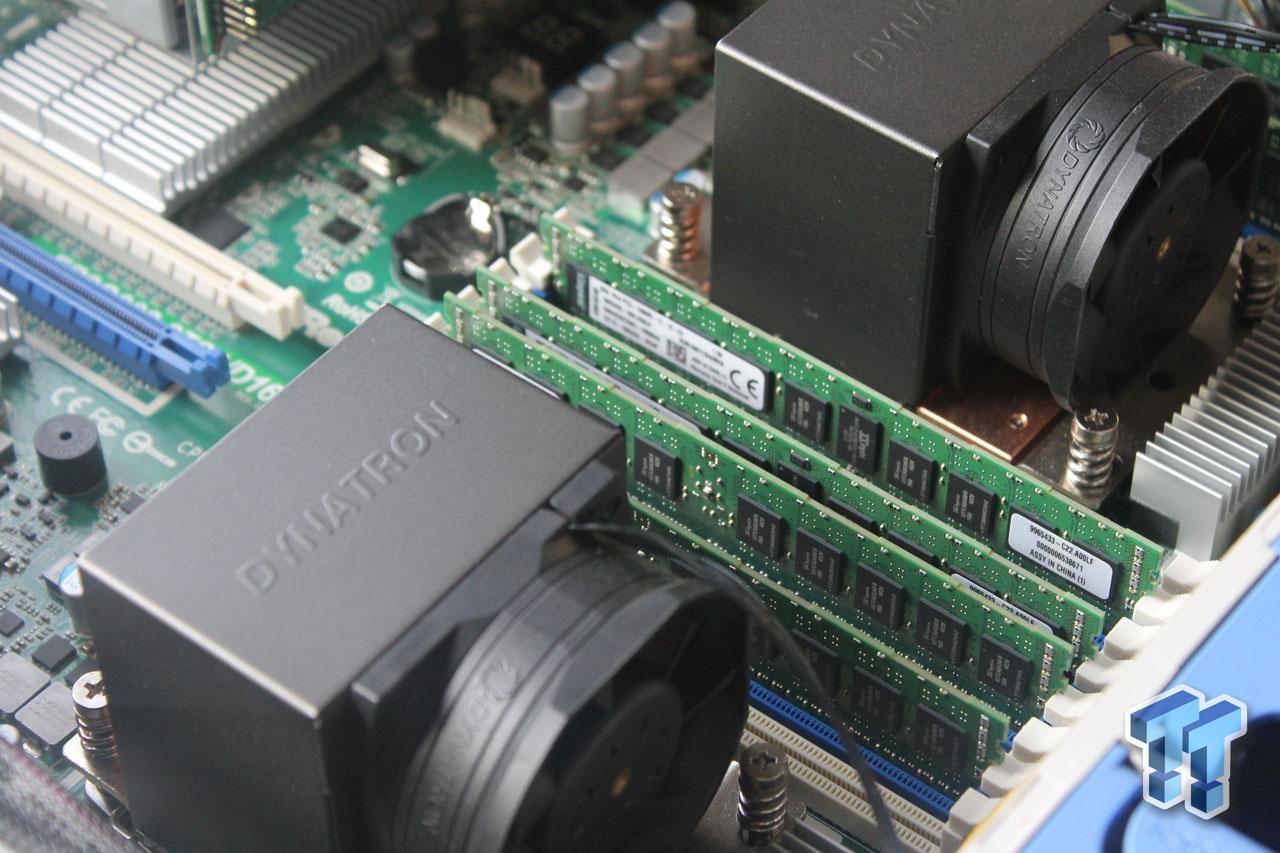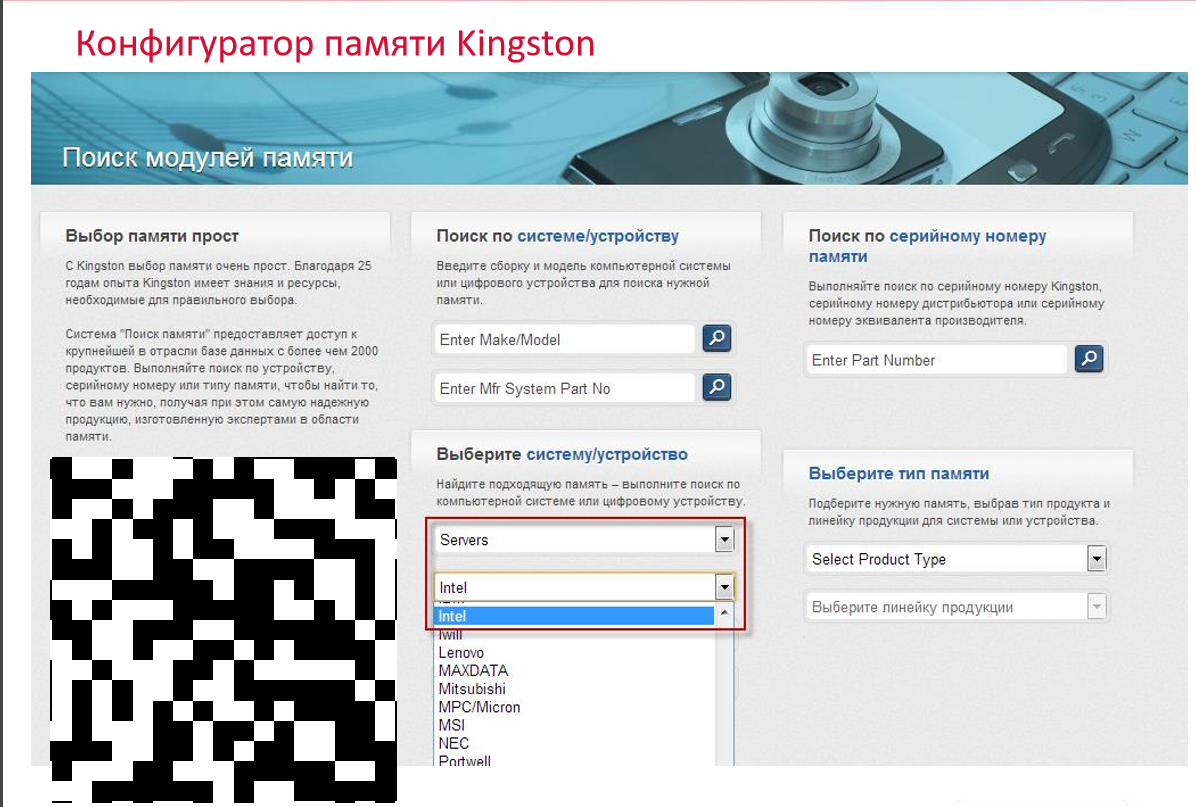A “crooked” server spoils the entire data center! Things to remember when choosing server memory
Hello Giktayms ! Non-specialists today are convinced that data centers are such “reserves of powerful servers” in which computers differ from home PCs only in performance and some nameplates / connectors. And if so, then the upgrade of server computers, it turns out that the task is ordinary? In reality, things are completely different, and today we will tell you how many nuances you have to consider even when choosing RAM for data centers.

Popularity is a windy lady, especially when we talk about devices for end users. Even if you pay attention to the means of access to the Internet, it is easy to see how desktops and laptops at first lost the share to tablets (“the era of post-PCs!”), And then these same tablet PCs almost completely annihilated, because smartphones with large screen size. The latter became the new kings of the mountain, with much greater Internet activity than all desktops and hybrid PCs combined. Tomorrow, manufacturers will “polish” new ideas in smart watches or folding tablet phones - and the pendulum will again swing in the opposite direction.
But the situation with data centers is much more clear - the number of Internet users is growing, the content is getting heavier, cloud services are gaining in popularity, the load on server hardware is increasing. From year to year, there are more and more data centersthemselves - Internet giants are switching from standard options to crafted, self-designed data centers (data centers) with equipment, cooling and personnel to your taste. But the turnkey data centers are experiencing their boom in Russia - for political reasons , and nonetheless.
Let’s be realistic - today giant companies are building data centers from scratch in an open field, more often companies resort to leasing computing power or deploy their own configured server rooms on leased premises. Today we will mention important little things that you need to consider when choosing server configurations - we understand what needs to be taken into account at the iron and organizational levels when selecting memory for a server.
Since the mainstream servers acquired processors based on the x86 architecture, they have become, as they say, closer to the people and often experience their second youth in gaming computers for enthusiasts. Not because they are ideally suited for gaming tasks, but because morally obsolete server hardware is sometimes cheaper than the gaming components of "home" computers.

Data centers are not only “their own atmosphere”, but also hardware with completely different tasks from gaming and office
With a gaming computer, server hardware is related only to high performance and standardized “family attributes” of memory. Only in the server, if we are talking about memory, memory does not account for short-term peak loads and simple most of the time, but work at the limit with a huge number of requests and operations per second. At the same time, the difference in energy consumption between several types of memory is not “savings on matches”, as gamers call it, but tangible expenses of the organization’s budget. And the cooling of components is also designed for "marathons", and not on the principle of "it doesn’t seem to be throttling with my use case - that's good."
Finally, excessive reliability (it sounds strange, but in everyday work scenarios moral obsolescence will come before the server hardware resource is exhausted) and memory capacity is not a matter of prestige in any form, but a consequence of constantly high loads and RAM consumption, for example, by databases SQL, virtualization and, moreover, In-Memory databases, in which RAM is the main data warehouse.
From the above it may not be entirely clear why large companies prefer not to get involved in purchasing extremely cheap memory using “seemingly normal chips” with a maximum capacity margin and prefer “high-profile brands”. And there are several reasons:

Kingston memory stress test before its release
If you can still take a chance in your home computer, buy a “non-standard chips” and, in the worst case, be upset by the BSOD in the game or while working in the browser and the amount spent on the purchase, then in a situation when the server “crashes”, the company starts to lose money immediately (especially if the server is running for e-commerce needs). And in such a situation no one will be comforted, how much Vasya saved when buying memory at a bargain price - even if he quickly replaces the memory, “picks up” the server and “puts it”, wasted money on low-quality RAM, the hassle of tech support staff and an unscheduled “hole” there’s nothing good about attendance.

For this reason, the data center almost always uses the memory of brands that not only “stick the chips on the printed circuit board”, but also control the creation of memory and check the products for problems before sending them on sale. Kingston, for example, manages the entire RAM production cycle, from the plate to the chips, and uses 35 quality tests (including a 24-hour stress test at 100 degrees Celsius on high voltage). And only after successfully passing all the tests, the modules are sent to the hands of customers. Such testing is not paranoia or marketing, but an urgent need, because in this way Kingston ensures that, for example, each cell in the 16-gigabyte module (and there are more than 136 billion of them in the module).

University of Toronto Research Provesthat a module failure does not pass without a trace, even if the ECC corrected the error
Modern servers use DDR3 and DDR4 memory, but not all in a row, but of the following varieties:

Register memory Kingston DDR3 KVR-16R11S4 8HA on Ivy Bridge-EP platform
Most appreciated for the ability to pile up an impressive (9-12 modules per processor) number of modules and thus maximize the amount of RAM in the server.
The general principles of the selection are similar to those that we remember on a PC for home use - sets of the same memory are always faster and more stable than “vinaigrette” from modules with different characteristics, in installing modules with voltage 1.35V and 1.5V, the voltage on all modules will equalize to favor 1.5V. In multiprocessor systems, memory must be configured in the same way. Maximum speed depends on the processor, because the memory controllers are now located just under the CPU cover.

Types of memory modules for servers
Even in an ideal world with “spherical in a vacuum” platforms and memory modules, incompatibilities or bugs happen. Or the company works with branded equipment, in conflicts of which an unclean leg will break. And someone just wants to minimize headaches and get as little as possible into the “pitfalls” and instances of unstable memory, without overpaying for individual consultations.
Moreover, the creators of branded servers have a glorious tradition of "tearing their customers" for service and components after the end of the equipment warranty. Fortunately, vendor lock-in has not yet spread to server hardware, which means that it is never too late for independent component manufacturers to change authorized services with the logic “nowhere to go and pay what we say”.

And even the level of service after such castling will be only higher. For example, because Kingston, unlike most competitors, by the way, has a full-fledged representative office in Russia. All warranty issues are resolved without the slightest stress, and in principle, buyers will not have a situation typical for communicating with distributors: “I just posted an announcement, please contact those guys in China for technical advice.”
Any compatibility and memory installation issues can be overcome quickly and easily. And you can check the compatibility and performance of the memory not only with the help of documentation and collective intelligence on the Internet / by technical support phone (by the way, call 8-800-700-13-50, on weekdays 10:00 to 18:00), but also “ profit "! Kingston will issue a test kit before purchase, and if it doesn’t start, the customer is guaranteed a refund. Whether you will be skeptical or not, will it be skeptical or not, but it’s difficult to name at least one more vendor in the Russian Federation with the same freedom in selecting server hardware.

Selection of the optimal memory for the server begins with the configurator . For everything else, there is an official Russian representative office of Kingston and a huge number of distributors
In addition, with “local control”, Kingston delivers memory to customers, in most cases faster than competitors, and you can get a discount on iron when ordering large batches or tenders without any problems - this is also a noticeable difference from the practice of “I am an implementer, not a person who determines pricing policy, buy it as it is. ”
There is a huge amount of nuances in server memory that cannot be covered in one article, but the preamble is time and the hardcore is an hour. Stay with us - we still have something to tell about the specifics of server hardware!
For more information on Kingston and HyperX products, visit the company's official website . A page with a visual aid will help you choose your HyperX kit .

Popularity is a windy lady, especially when we talk about devices for end users. Even if you pay attention to the means of access to the Internet, it is easy to see how desktops and laptops at first lost the share to tablets (“the era of post-PCs!”), And then these same tablet PCs almost completely annihilated, because smartphones with large screen size. The latter became the new kings of the mountain, with much greater Internet activity than all desktops and hybrid PCs combined. Tomorrow, manufacturers will “polish” new ideas in smart watches or folding tablet phones - and the pendulum will again swing in the opposite direction.
But the situation with data centers is much more clear - the number of Internet users is growing, the content is getting heavier, cloud services are gaining in popularity, the load on server hardware is increasing. From year to year, there are more and more data centers
Let’s be realistic - today giant companies are building data centers from scratch in an open field, more often companies resort to leasing computing power or deploy their own configured server rooms on leased premises. Today we will mention important little things that you need to consider when choosing server configurations - we understand what needs to be taken into account at the iron and organizational levels when selecting memory for a server.
Why the server is not a home PC "on steroids"
Since the mainstream servers acquired processors based on the x86 architecture, they have become, as they say, closer to the people and often experience their second youth in gaming computers for enthusiasts. Not because they are ideally suited for gaming tasks, but because morally obsolete server hardware is sometimes cheaper than the gaming components of "home" computers.

Data centers are not only “their own atmosphere”, but also hardware with completely different tasks from gaming and office
With a gaming computer, server hardware is related only to high performance and standardized “family attributes” of memory. Only in the server, if we are talking about memory, memory does not account for short-term peak loads and simple most of the time, but work at the limit with a huge number of requests and operations per second. At the same time, the difference in energy consumption between several types of memory is not “savings on matches”, as gamers call it, but tangible expenses of the organization’s budget. And the cooling of components is also designed for "marathons", and not on the principle of "it doesn’t seem to be throttling with my use case - that's good."
Finally, excessive reliability (it sounds strange, but in everyday work scenarios moral obsolescence will come before the server hardware resource is exhausted) and memory capacity is not a matter of prestige in any form, but a consequence of constantly high loads and RAM consumption, for example, by databases SQL, virtualization and, moreover, In-Memory databases, in which RAM is the main data warehouse.
From the above it may not be entirely clear why large companies prefer not to get involved in purchasing extremely cheap memory using “seemingly normal chips” with a maximum capacity margin and prefer “high-profile brands”. And there are several reasons:

Kingston memory stress test before its release
Fault tolerance is the most important thing
If you can still take a chance in your home computer, buy a “non-standard chips” and, in the worst case, be upset by the BSOD in the game or while working in the browser and the amount spent on the purchase, then in a situation when the server “crashes”, the company starts to lose money immediately (especially if the server is running for e-commerce needs). And in such a situation no one will be comforted, how much Vasya saved when buying memory at a bargain price - even if he quickly replaces the memory, “picks up” the server and “puts it”, wasted money on low-quality RAM, the hassle of tech support staff and an unscheduled “hole” there’s nothing good about attendance.

For this reason, the data center almost always uses the memory of brands that not only “stick the chips on the printed circuit board”, but also control the creation of memory and check the products for problems before sending them on sale. Kingston, for example, manages the entire RAM production cycle, from the plate to the chips, and uses 35 quality tests (including a 24-hour stress test at 100 degrees Celsius on high voltage). And only after successfully passing all the tests, the modules are sent to the hands of customers. Such testing is not paranoia or marketing, but an urgent need, because in this way Kingston ensures that, for example, each cell in the 16-gigabyte module (and there are more than 136 billion of them in the module).

University of Toronto Research Provesthat a module failure does not pass without a trace, even if the ECC corrected the error
There is no "coolest type of memory" - there are suitable and not suitable for the equipment varieties
Modern servers use DDR3 and DDR4 memory, but not all in a row, but of the following varieties:
- Unbuffered ECC DIMM is what experts call the word UDIMM. Typical memory modules up to 8 GB each - the most budget option in servers and workstations. It differs from “just RAM” for home PCs by the presence of an ECC circuit, which detects and corrects errors in individual bits of memory.
- Registered DIMM - that same registered memory, which de facto became the hallmark of servers and workstations of the middle class. The most common option in wide retail. Modules up to 32 GB each, slightly slower than non-register, but noticeably more reliable. It always supports ECC and is more practical than Unbuffered, because it scales much better (number of modules per channel).
- Load Reduced DIMM or LRDIMM - the "last peep" (2013 and newer) mods in server platforms. It is compatible with RDIMM connectors, but it is arranged differently - the modules have a memory buffer for transferring data from the host to DRAM, that is, LRDIMM takes on some of the functions of the memory controller, and the controller itself works in serial mode. By reducing the electrical load, the memory is either faster than an RDIMM with a higher clock frequency, or at a much higher capacity than its predecessors at a similar frequency. Monitoring tools also got better.

Register memory Kingston DDR3 KVR-16R11S4 8HA on Ivy Bridge-EP platform
Most appreciated for the ability to pile up an impressive (9-12 modules per processor) number of modules and thus maximize the amount of RAM in the server.
The general principles of the selection are similar to those that we remember on a PC for home use - sets of the same memory are always faster and more stable than “vinaigrette” from modules with different characteristics, in installing modules with voltage 1.35V and 1.5V, the voltage on all modules will equalize to favor 1.5V. In multiprocessor systems, memory must be configured in the same way. Maximum speed depends on the processor, because the memory controllers are now located just under the CPU cover.
- NVDIMM - a mixture of the
hedgehog and hedgehogfamiliar RAM and SSD, a hybrid non-volatile memory . It is installed in standard DIMM connectors and is compatible, but it comes with a stand-alone power supply. Does not lose data in the event of a power failure. Not very popular yet, but already used in cloud computing.

Types of memory modules for servers
You can complete data centers without support, but it’s sad
Even in an ideal world with “spherical in a vacuum” platforms and memory modules, incompatibilities or bugs happen. Or the company works with branded equipment, in conflicts of which an unclean leg will break. And someone just wants to minimize headaches and get as little as possible into the “pitfalls” and instances of unstable memory, without overpaying for individual consultations.
Moreover, the creators of branded servers have a glorious tradition of "tearing their customers" for service and components after the end of the equipment warranty. Fortunately, vendor lock-in has not yet spread to server hardware, which means that it is never too late for independent component manufacturers to change authorized services with the logic “nowhere to go and pay what we say”.

And even the level of service after such castling will be only higher. For example, because Kingston, unlike most competitors, by the way, has a full-fledged representative office in Russia. All warranty issues are resolved without the slightest stress, and in principle, buyers will not have a situation typical for communicating with distributors: “I just posted an announcement, please contact those guys in China for technical advice.”
Any compatibility and memory installation issues can be overcome quickly and easily. And you can check the compatibility and performance of the memory not only with the help of documentation and collective intelligence on the Internet / by technical support phone (by the way, call 8-800-700-13-50, on weekdays 10:00 to 18:00), but also “ profit "! Kingston will issue a test kit before purchase, and if it doesn’t start, the customer is guaranteed a refund. Whether you will be skeptical or not, will it be skeptical or not, but it’s difficult to name at least one more vendor in the Russian Federation with the same freedom in selecting server hardware.

Selection of the optimal memory for the server begins with the configurator . For everything else, there is an official Russian representative office of Kingston and a huge number of distributors
In addition, with “local control”, Kingston delivers memory to customers, in most cases faster than competitors, and you can get a discount on iron when ordering large batches or tenders without any problems - this is also a noticeable difference from the practice of “I am an implementer, not a person who determines pricing policy, buy it as it is. ”
There is a huge amount of nuances in server memory that cannot be covered in one article, but the preamble is time and the hardcore is an hour. Stay with us - we still have something to tell about the specifics of server hardware!
For more information on Kingston and HyperX products, visit the company's official website . A page with a visual aid will help you choose your HyperX kit .
